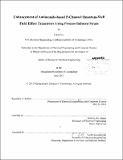Enhancement of antimonide-based p-channel quantum-well field effect transistors using process-induced sprain
Author(s)
Guo, Luke (Luke W.)
DownloadFull printable version (7.204Mb)
Other Contributors
Massachusetts Institute of Technology. Department of Electrical Engineering and Computer Science.
Advisor
Jesús A. del Alamo.
Terms of use
Metadata
Show full item recordAbstract
For decades, the scaling of silicon CMOS has brought impressive growth to the semiconductor industry, as well as a wealth of technological innovations. However, the continued scaling of CMOS devices to the nanometer regime is now threatened by intrinsic limitations to the use of silicon as the channel material. Hence, there is a strong interest in III-V semiconductor materials to replace silicon as the channel material as a result of their outstanding electron transport properties. While III-V materials have demonstrated impressive n-channel field-effect transistors (FETs), the same success has not yet been translated to the development of a high-performance III-V pchannel FET. This is because while many III-V's have high electron mobilities, they generally have very poor hole mobilities. The development of a high-performance III-V p-channel FET is critical to the realization of a future-generation III-V CMOS architecture. Among the III-Vs, the antimonides have the highest hole mobilities. This makes them attractive for developing a 111-V p-channel FET. This thesis examines the use of process-induced uniaxial strain combined with biaxial strain introduced during growth of the heterostructure as an approach to enhance antimonide-based FETs. Using a compressively stressed silicon nitride layer to induce uniaxial strain in the device, stressed devices with an InGaSb channel were fabricated and compared with unstressed devices processed in parallel. Enhancements of >50% in the intrinsic transconductance were observed as well as reductions of >30% in the source-drain resistance. This work illustrates the effectiveness of uniaxial strain in improving the performance of antimonide FETs.
Description
Thesis (S.M.)--Massachusetts Institute of Technology, Dept. of Electrical Engineering and Computer Science, 2013. Cataloged from PDF version of thesis. Includes bibliographical references (p. 55-57).
Date issued
2013Department
Massachusetts Institute of Technology. Department of Electrical Engineering and Computer SciencePublisher
Massachusetts Institute of Technology
Keywords
Electrical Engineering and Computer Science.